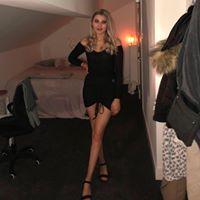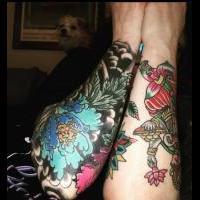Grez Interview from 2010, pt. 1
All right LSTers, here's an older interview I did with the very talented Grez from King's Avenue from last year. The magazine in which it appeared only published a very abbreviated version and, after talking with Lochlan and getting permission from Grez to post it, I thought this would be a good place to share the full version.
Since it is somewhat dated and a portion of it already appeared, most magazines wouldn't be interested. And since I've shelved the book project for now, was just looking for a kind of free and open place to share. It's not quite as exciting as a video interview, I know, but it's a good read and there are some great pieces of advice in here.
Grez talks about getting tattooed by D. E. Hardy and Chris Conn, his realization of how important the use of black is, and the biggest thing he's learned from tattooing. Massive question. Stay tuned for part 2. Hope you enjoy.
Let’s start with a little background information.
The first tattoo I ever did was February 1, 2000. I have a photo with a little digital imprint and I use that as my marker. I started in Syracuse, NY, my hometown. I was in college and graduated in ’99. About halfway through college, two of my best friends opened up a shop in Syracuse called Halo Tattoo. I was there for the opening and was constantly there during breaks, like for Christmas break I would be there all day every day because they were hardcore kids I knew from the music scene that just happened to be tattooers.
I was an art major in college and started collecting [tattoos] at a young age. They offered to teach me and I kind of hinted at it. I was hanging out and doing a lot of drawing and was hoping my friend Ron would ask. He agreed to teach me when I graduated. So I graduated in ’99 and started tattooing in 2000, February 1st. And a couple months later they unleashed me on the clients.
I was there for about two and a half years. I knew at that point, even before I started at Halo, I told them, “Listen, I’m going to stick it out for a couple years but I need to be in a bigger city.” They’re the best people in the world there, in Syracuse, they’re my best of friends, but I just felt like I needed the city life, a little more fast-paced. Now, I’m actually trying to get out of that.
Where did you move after Syracuse?
My wife and I moved to Boston. We lived in Boston for three years. I worked at Redemption tattoo in Cambridge, [Massachusetts]. I met Mike [Rubendall] at a convention in probably 2003. It’s pretty random how I ended up here but I feel like it was destiny, because he and I get along so well.
He was tattooing my best friend. He was doing a sleeve on him, and I call my friend who was living in Queens to tell him my wife and I were moving to New York and he just happened to be with Mike. And Mike got on the phone and said, “Hey, you wanna work for me?” And I said “Absolutely.” I came out and hung out with him for a day or two, shook his hand, and moved here a few months later.
This shop is amazing.
It’s crazy. When Mike first opened, when he was putting the shop together, he asked what kind of surfaces we should get to work on, and I didn’t want to throw out anything too expensive. I didn’t want to tell him anything too crazy. And then I came to the shop and see granite floors and I’m like “Oh my God, never mind! You got it under control.”
We came out here and this place was demoed and two weeks later, the amount of work that was done I couldn’t believe it. I’d say he did probably 75% of it in a month. He had guys working around the clock. When I moved here, he said he’d hoped to be open in July. But he found a few places and they weren’t down with having a tattoo shop in there. So he lost a few [places] and then we didn’t open until November. I was trying to travel a lot and just make money while he was trying to find a location. And then he found this location, which is a few blocks away from where he grew up, so it seems perfect that he came back here.
I know nothing about Long Island...
I didn’t either. The first time I ever came out here to meet him was the first time I’d ever been to Long Island. I live in Queens and I commute out here but it’s really not bad.
I work five days a week, sometimes six. I haven’t been doing that in a while because I got really burned out on it.
That brings me to the next point that it’s so apparent that everyone here works so hard. There’s none of that two or three days a week nonsense.
Yeah, everyone here really busts their asses. That’s something that’s great about Mike. He’s not one of those guys that watches workers bust their ass just so he doesn’t have to work. He’s just as intense about his work as everyone here. I’ll look at him and I can’t be stressed. He’s got so much more on his plate than I do. He has everything done on time and he’s a great person to work for because he’s still truly passionate about tattooing.
I was even talking to a tattooer the other day and he said it was such a bummer to work for people who don’t care about tattooing anymore. Because then you just feel like you’re working for them. They’re not trying to learn anything. Here, it’s just such a healthy environment for all of us.
Any of these guys can come up to me and be honest. Say when I put a drawing on the table, they can say, “This is wrong, this is wrong and that’s wrong.” They know my work and they see my drawings every day. Sometimes they can pinpoint problems with [the drawing] that I don’t see because I’ve been staring at it too long. I trust these guys enough that they’re not just screwing with me. I’ll take their points into considerations and make a lot of changes because of them.
Everyone’s honest with each other and it’s really rare. I’ve worked at some shops guest-spotting and it’s almost like the tattooers are competitive and it’s so unhealthy, like an unhealthy competitiveness. They’re just kind of looking over everyone’s shoulders and it’s just not a healthy environment.
Your tattoos have such a great look to them, no matter what it is. How do you think your style’s evolved since you started?
Starting at Halo, those guys did a lot of traditional work and that was what I was more drawn to as far as tattoos go. By starting off with traditional, it just gave me the perfect foundation to learn. You hear it a lot, but American traditional is just the best formula to learn. It’s clean lines, solid color and shading. It’s usually a third black, a third color and a third skin. It’s such a great recipe to build a tattoo that lasts.
That’s what I feel my foundation was but when I look at my old work… You know, when you sit there and you’re drawing and an apprentice, I would sit there and I knew I had so much to learn. Looking back, I feel like my older work wasn’t really traditional because it didn’t have any kind of weight to it.
I think a lot of that comes with having confidence in your work. I didn’t have confidence putting in huge fields of black and color, or to use heavier lines. But as I became more confident with the machines and my own work, starting to work with other artists from out of town, like from DC, some of the guys from Jinx Proof and Adam Barton came from California. We hit it off and we actually connected more through music than we did through tattoos. But working with him, painting flash together, it really took my work forward.
I took huge steps forward because when I thought I was putting a lot of black in my work, I realized I wasn’t really putting any. I saw how powerful his work was with the heavy amount of weight and all the black. I feel like that was a pinpoint in my career that really showed me that I was going in the right direction but not doing anything right. I kind of wasn’t doing adult-looking tattoos, you know? I was kind of dancing around and doing too many fades, trying to make things too fancy. When all I needed to do was strip everything down more.
Do you try to keep a traditional thread running through your work?
No, I think it depends on the image. Sometimes I can do things really simple and sometimes I render them with a lot more depth. I like doing a lot of black and gray, also, which isn’t really related at all to traditional American, it’s more like Renaissance and Christian artwork. People come in for crosses or a cross and rosary beads and I love doing that stuff. I feel like it’s a good break from the traditional American stuff. A lot of people come in for Japanese, too, and I’ve been doing a bit of that, but I feel like it’s impossible to break from the American influence on my work, which is okay with me.
It’s a little heavier and stiffer, but I like that I’m not trying to make it look like Horiyoshi, but more like an American kid’s take on Japanese themes.

















0 Comments
Recommended Comments
There are no comments to display.